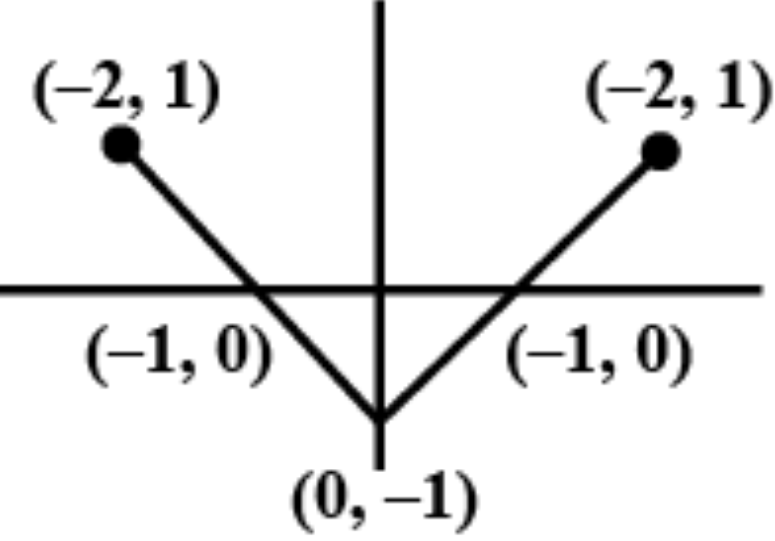For the function y=f(x)=(x2+bx+c)ex, which of the following holds?
If f(x)>0 for all real xcancelrArrf'(x)gt0
If f(x)>0 for all real x⇒f'(x)>0
If f'(x)>0 for all real x⇒f(x)>0
If f'(x)>0 for all real xcancelrArrf(x)gt0
The correct Answer is:A, C
To solve the problem, we need to analyze the function y=f(x)=(x2+bx+c)ex and determine the validity of the given options regarding the relationship between f(x) and its derivative f′(x).
Step 1: Identify the function and its components
The function is given as:
f(x)=(x2+bx+c)ex
Here, ex is always positive for all real x.
Step 2: Differentiate the function using the product rule
To find f′(x), we will apply the product rule, which states that if u(x) and v(x) are functions of x, then:
(uv)′=u′v+uv′
Let u(x)=x2+bx+c and v(x)=ex.
Calculating the derivatives:
- u′(x)=2x+b
- v′(x)=ex
Now applying the product rule:
f′(x)=u′(x)v(x)+u(x)v′(x)
Substituting the values:
f′(x)=(2x+b)ex+(x2+bx+c)ex
Factoring out ex:
f′(x)=ex((2x+b)+(x2+bx+c))
Simplifying further:
f′(x)=ex(x2+(b+2)x+(b+c))
Step 3: Analyze the conditions for positivity
Since ex is always positive, the sign of f′(x) depends on the quadratic expression:
g(x)=x2+(b+2)x+(b+c)
Step 4: Determine conditions for g(x)
To analyze when g(x) is positive, we need to consider the discriminant:
D=(b+2)2−4⋅1⋅(b+c)
For g(x) to be positive for all x, we need:
1. D<0 (no real roots, hence always positive)
2. The leading coefficient (which is 1) is positive.
Step 5: Evaluate the options
1. Option 1: If f(x)>0 for all x, it does not imply f′(x)>0.
- This is True. If f(x) is positive but has a local maximum or minimum, f′(x) can be zero or negative.
2. Option 2: If f(x)>0, then f′(x)>0.
- This is False. As shown in the analysis, f(x)>0 does not guarantee f′(x)>0.
3. Option 3: If f′(x)>0, then f(x)>0.
- This is True. If the derivative is positive, the function is increasing, and since it starts from a positive value, it remains positive.
4. Option 4: If f′(x)>0, it does not imply f(x)>0.
- This is False. If f′(x)>0, it indicates that f(x) is increasing, and if it started positive, it will remain positive.
Conclusion
The correct options are:
- Option 1: True
- Option 3: True
The function is given as:
f(x)=(x2+bx+c)ex
Here, ex is always positive for all real x.
To find f′(x), we will apply the product rule, which states that if u(x) and v(x) are functions of x, then:
(uv)′=u′v+uv′
Let u(x)=x2+bx+c and v(x)=ex.
- u′(x)=2x+b
- v′(x)=ex
f′(x)=u′(x)v(x)+u(x)v′(x)
Substituting the values:
f′(x)=(2x+b)ex+(x2+bx+c)ex
Factoring out ex:
f′(x)=ex((2x+b)+(x2+bx+c))
Simplifying further:
f′(x)=ex(x2+(b+2)x+(b+c))
Since ex is always positive, the sign of f′(x) depends on the quadratic expression:
g(x)=x2+(b+2)x+(b+c)
To analyze when g(x) is positive, we need to consider the discriminant:
D=(b+2)2−4⋅1⋅(b+c)
For g(x) to be positive for all x, we need:
1. D<0 (no real roots, hence always positive)
2. The leading coefficient (which is 1) is positive.
1. Option 1: If f(x)>0 for all x, it does not imply f′(x)>0.
- This is True. If f(x) is positive but has a local maximum or minimum, f′(x) can be zero or negative.
- This is False. As shown in the analysis, f(x)>0 does not guarantee f′(x)>0.
- This is True. If the derivative is positive, the function is increasing, and since it starts from a positive value, it remains positive.
- This is False. If f′(x)>0, it indicates that f(x) is increasing, and if it started positive, it will remain positive.
The correct options are:
- Option 1: True
- Option 3: True
Topper's Solved these Questions
- DIFFERENTIATION BOOK - ARIHANT MATHS ENGLISHCHAPTER - DIFFERENTIATION EXERCISE - Exercise (Statement I And Ii Type Questions)
10 Videos
- DIFFERENTIATION BOOK - ARIHANT MATHS ENGLISHCHAPTER - DIFFERENTIATION EXERCISE - Exercise (Passage Based Questions)
16 Videos
- DIFFERENTIATION BOOK - ARIHANT MATHS ENGLISHCHAPTER - DIFFERENTIATION EXERCISE - SOLVED EXAMPLES
7 Videos
- DIFFERENTIAL EQUATION BOOK - ARIHANT MATHS ENGLISHCHAPTER - DIFFERENTIAL EQUATION EXERCISE - Exercise (Questions Asked In Previous 13 Years Exam)
26 Videos
- DY / DX AS A RATE MEASURER AND TANGENTS, NORMALS BOOK - ARIHANT MATHS ENGLISHCHAPTER - DY / DX AS A RATE MEASURER AND TANGENTS, NORMALS EXERCISE - Exercise (Questions Asked In Previous 13 Years Exam)
7 Videos
Similar Questions
Knowledge Check
The function f(x) =e|x| is
Acontinuous everywhere but not differentiable at x=0Bcontinuous and differentiable everywhereCnot continuous at x=0DNone of the aboveThe function f(x)=x2e−x strictly increases on
A[0,2]B[0,∞]C(−∞,0]∪[2,∞)Dnone of theseFor the function f(x)=ax2+bx+c,a≠0 , the sum of the roots is equal to the product of the roots . Which could be f(x) ?
Ax2−4x+4Bx2+x+2Cx2−2x+1Dx2+3x−6
The function f(x)=e|x| is
View SolutionThe graph of the function y=f(x). Then which of the following curve represent the graph of the function y=|f(x)|

View Solutionconsider the function f(X) =x+cosx
which of the following is not true about y =f(x)?
View SolutionLet dydx+y=f(x) where y is a continuous function of x with y(0) = 1 and f(x)={e−xifo≤x≤2e−2ifx>2 Which of the following hold(s) good ?
View SolutionA function is defined as f(x)=limx→∞[cos2nx , if x<0) , n√√1+xn, if 0≤x,+1) , 11+xn, if x>1 which of the following does not hold good?
View Solution
